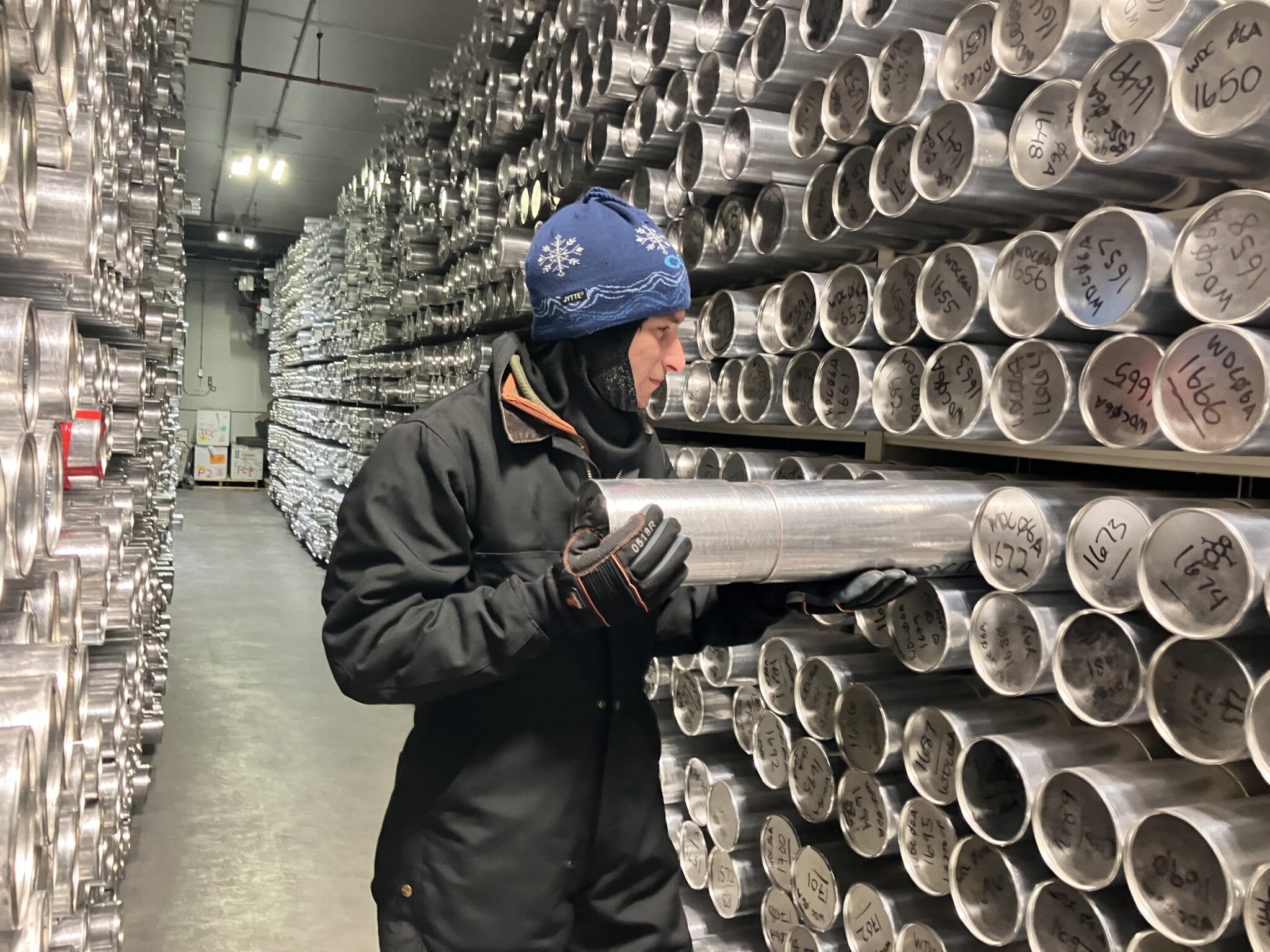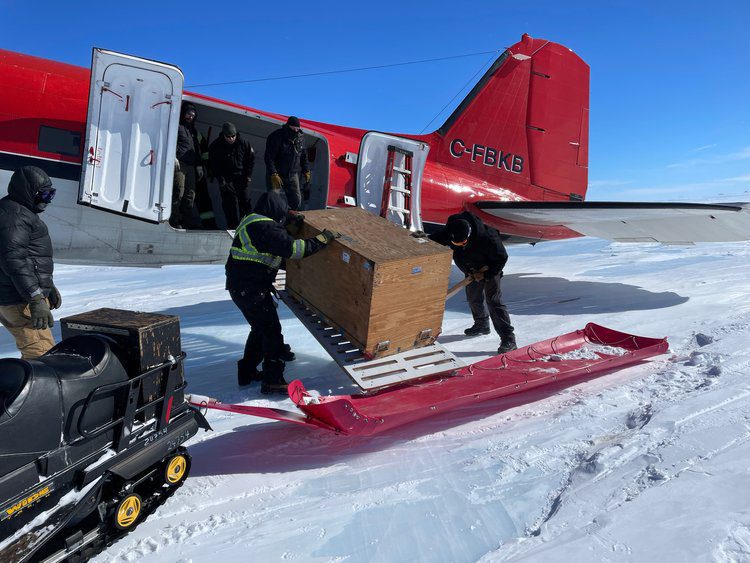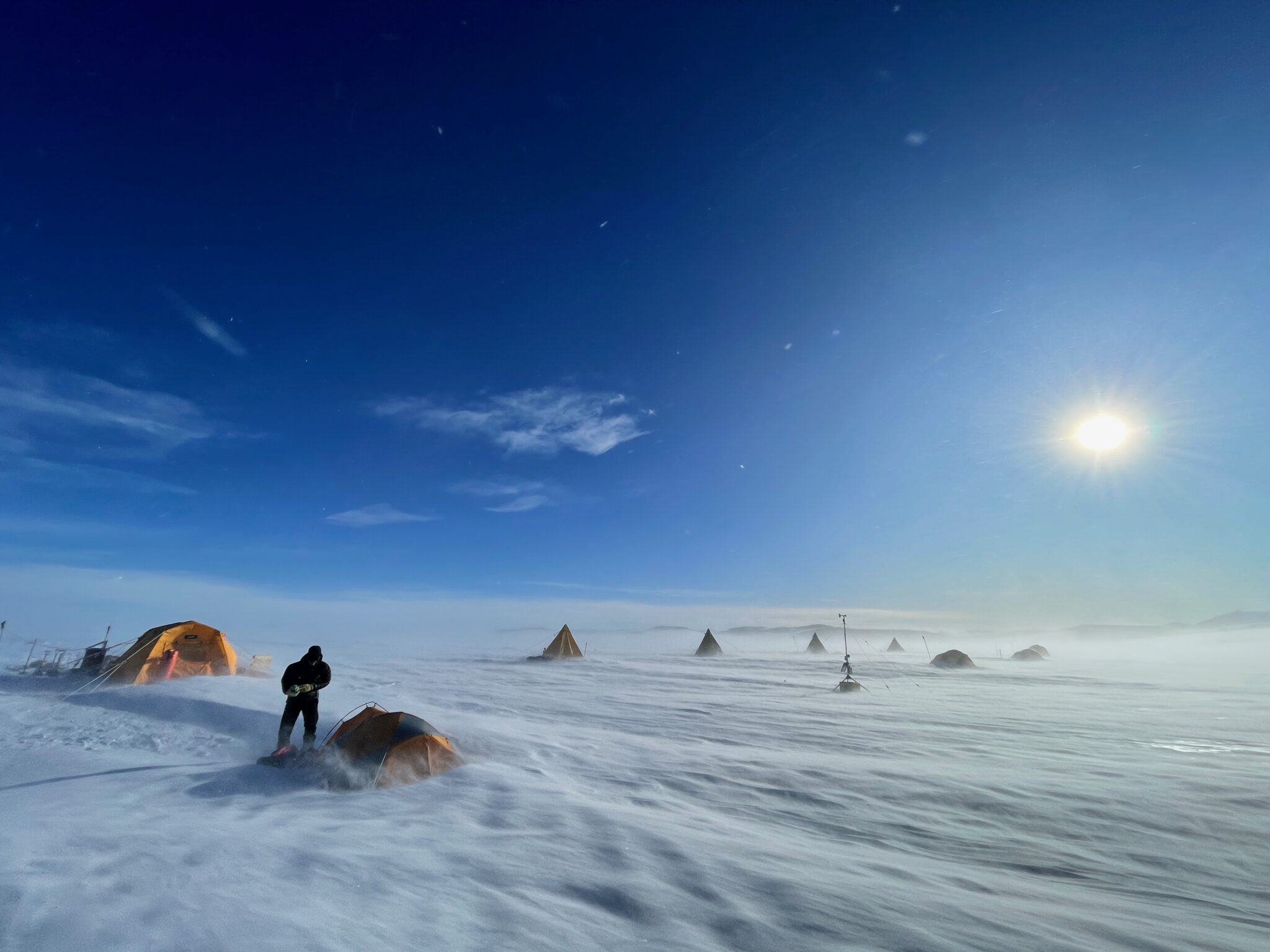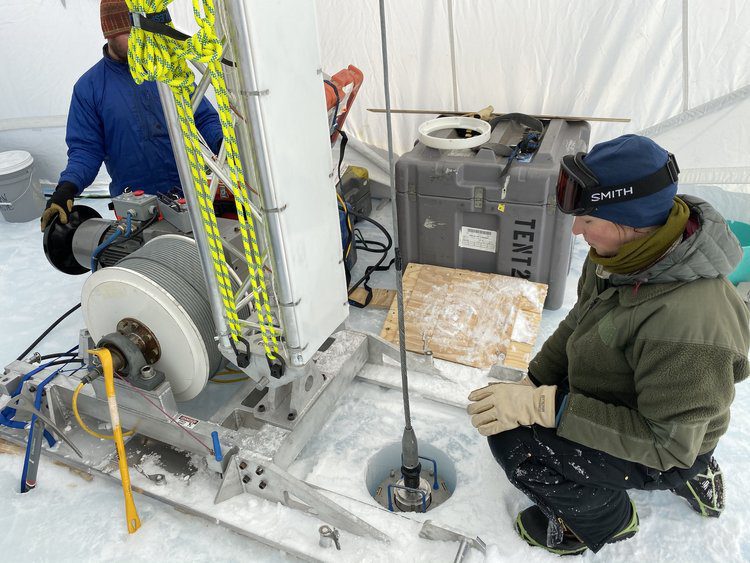By Tess Hunter, Managing Editor
Woodstock resident Jacob Chalif is on a mission to find “the oldest ice there is.” Chalif, at only 25 years of age, is joining a group of scientists and engineers on an expedition to a remote region of Antarctica in the hopes of better understanding the climate of our past in order to preserve the climate of our future.
Chalif is currently a graduate student at Dartmouth in the Earth Sciences department, where he also works as a lab manager at an ice core lab. “Basically all day, every day, I think of different ways to melt ice cubes,” Chalif told the Standard earlier this week. “We get ice cores from places all around the world, from high alpine areas like Denali or other mountains, like Greenland or Antarctica, and we bring these ice cores back to our lab, where we basically melt them and analyze the chemistry.”
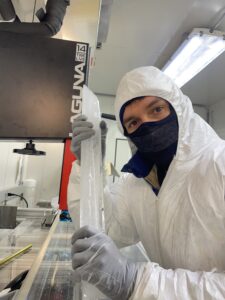
Jacob Chalif in the ice core freezer at Dartmouth, holding up a lab-made ice core. The core was made as a blank to test the system.
Photo Provided
Chalif measures things like sea salts, trace gasses, mineral dust, and heavy metals that are dissolved in the ice and uses that data to “say something about past climate,” he explains. “I like to say that our projections for future climate change are only as good as our best understanding of the fundamental processes that drive our atmosphere and our climate system. And for a lot of that, we have a really good idea how our atmosphere works. But for some of it, we still have some uncertainty about the chemistry of the atmosphere or circulation patterns, and [we] can use ice cores to figure out how it behaved in the past.”
Key to this understanding is the ice cores themselves, Chalif says. “In every single location that we’ve ever gotten into an ice core, we see undeniable fingerprints of human pollution and of human changes to the environment going back centuries. Not even just with the industrial revolution, but before that too. And then with industrialization, depending on where you look in the mid-19th or mid-20th century, you see this human fingerprint just skyrocket. We tend to think of these polar areas, where we get ice cores as pristine environments that haven’t been touched, but it’s kind of humbling and harrowing to see that even in these places, we have [left] these intense human fingerprints… We see lead at Denali. We see mercury in ice cores from the Alps from Roman smelting. We have these records going back hundreds of thousands of years, and [the impact is] nothing like what we’re [causing] today.”
For Chalif, the science behind climate has always been personal. “As long as I can remember, I loved the outdoors and the environment,” he says. “I grew up hiking in the Adirondacks. When I was going hiking as a kid, I’d hear that the mountains I was in were shaped by glaciers. Everything you see was put there by a glacier… It was kind of mind-boggling to hear that. I never really understood what that meant, but looking back, I think that planted a seed. I just kind of developed this love for the environment.”
Chalif originally attended Dartmouth intending to study climate and environmental policy. But during a class called “Climate Dynamics,” he had an epiphany. “It was the very first time I was ever exposed to hard climate science,” he says. “And I had naively thought that we already knew everything there was to know about climate science and climate change, and that’s just not true. We know the broad strokes, but what precise ways the climate is going to change? There’s still a lot of open questions. It was really exciting to read these debates, understand them and even contribute to them.”
Chalif will journey to Antarctica next month with the U.S. National Science Foundation Center for Oldest Ice Exploration — or NSF COLDEX — a multi-institutional organization funded by the federal government. “The whole goal of this organization is to find the oldest ice cores. We are interested in that because there are these fundamental drivers to our climate system that we still are pretty unsure of. For example, why do we have ice ages and why do we have warm periods like today?
He continues, “What COLDEX is doing is, we’re going to this coastal area in Antarctica, which is not normally where you would go to find old ice, but in this one really weird spot because of the topography of the ground in these mountains, old ice from the bottom of the ice sheet is actually forced to come up on the surface. You can imagine old rocks, like an outcropping on the earth. And so you actually don’t need to dig down all that far to get really, really old ice. The old record for oldest ice was 800,000 years. But [here], we found ice upwards of four million years old, basically on the surface. And so the goal of COLDEX is to do as much sampling as we can in this area.”
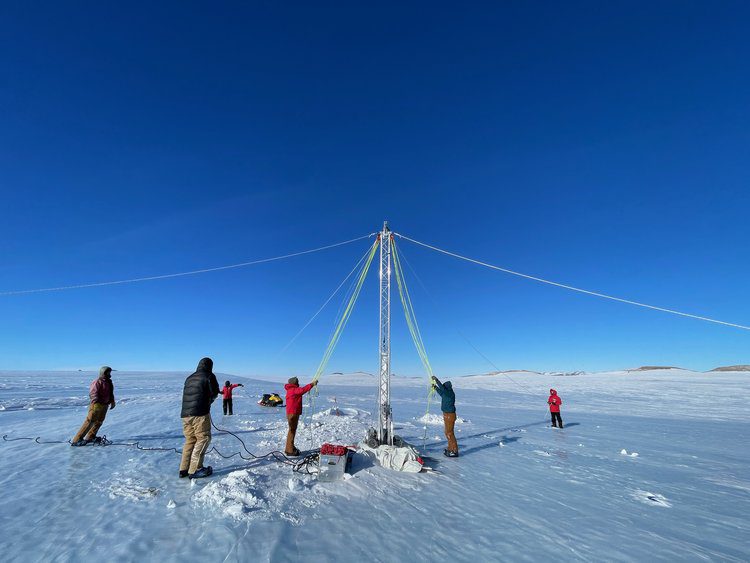
Day one of the expedition will see the team raising a drill site in the ice. Pictured, the team raises the drilling tower for the Blue Ice Drill in December 2022. Photo by Peter Neff
Chalif says the area, Allen Hills, has been a hotspot for scientists for about 60 years. “It began a long time ago, because people would go to Antarctica to hunt for meteorites, and basically, for the same reason that we have old ice at the surface, meteorites actually tend to accumulate in this one spot that we’re going to as well. So you can go there and just find a treasure trove of meteorites.”
According to Chalif, determining the age of ice is not all that different from counting the rings in a tree trunk. “We usually look at ice that is only a couple thousand years old. And for ice like that, generally, you can count annual layers in the ice,” he says. “It’s called water isotopes — basically, it’s a proxy for temperature. So you can just see little wiggles where in the winter it’s colder, in the summer it’s warmer, and you can just count the wiggles going back a few thousand years.”
But Chalif notes that the dating process is more complicated for older ice like the kind they will be harvesting in Antarctica. “For this project, you can’t really count years for this really, really, really old ice. It’s just too squeezed together and messed up… But what people at Princeton figured out how to do is to measure the isotopes of Argon in the ice core within this ultra-trace atmospheric gas… Our planet is basically belching out [argon] at a constant rate. So we can just measure how much argon 40 there is compared to today, and derive age. In practice, it’s really complicated to do that, but that’s the basic idea.”
The opportunity to go to Antarctica came to Chalif somewhat by happenstance. He currently works on ice retrieved from the Allen Hills site in his lab at Dartmouth and says that when NSF COLDEX came looking for recruits, Chalif raised his hand. “I did not expect that they would call me up. But at first they put me on as an alternate, so if someone else dropped out, then I would join the team. Usually, if you’re an alternate, you don’t end up going. Usually people don’t drop out. But unfortunately, this year, one person — and he would have been wonderful — but for logistical reasons, he could not end up coming, which is sad.”
Chalif says he and his wife (Standard reporter Lauren Dorsey) were leaving their favorite restaurant — Trail Break Tacos in Quechee — in late July when he got the email with the news. “We were walking out the door and I get this email from the [director], telling me that they want to put me on the main field team. My wife thought someone died. I froze. I was speechless. She was like, ‘What happened?’ I couldn’t even speak. I was just like, ‘Look at my phone.’”
Even being on the alternate team required a rigorous qualification process. “There are limitations on who can go to Antarctica because it’s such an inhospitable place far from normal medical resources and day-to-day comforts,” says Chalif. “So you just need to have a clean bill of health to go. It can be quite an intense process [to physically qualify], but I had to see a bunch of doctors and check all the boxes.”
The team journeying to Antarctica will include about a dozen scientists, graduate students, and engineers — many of whom Califf already knows through the insular community of ice core specialists. Chalif will depart the U.S. for Christ Church, New Zealand on or around Oct. 30. Once there, the group will convene at a center for the U.S. Antarctic program, where they will collect their cold weather gear and supplies for the trip. From there, the team will fly to the McMurdo station in Antarctica. During a two-week stint at McMurdo, Chalif and the team will be doing field safety training and learning basic skills, such as how to set up their tents in windy conditions. They will also learn how to drill the ice and log the data they uncover. “There’s some downtime,” says Chalif. “So we go for hikes, we go see the seals, we go for runs and things like that. Then, on or about Nov. 19, we fly from McMurdo in these tiny little propeller planes through the Transantarctic mountains to our field site at the Allan Hills.”
Day one of the project will be setting up the drill tents, Chalif says. “The drill structure itself kind of supports the tent. And then every day, day in and day out, you just send the drill down, and you pick up a meter [of ice] at a time and bring it to the surface. Then me and the other scientists there, we’ll get the ice, we’ll do all sorts of measurements on it, do what’s called a data logging so we know, like, which piece of ice is which, and then store it safely while the drillers go down and get the next meter. And we’ll do this every single day for about two months.”
Challiff will be at that site in the Allan Hills until roughly mid-January. “In Antarctica, you don’t only drill ice cores in summer. Our winter is the southern hemisphere’s summer, and so the only time to go drill ice cores is during this very short three-month weather window.”
The journey from the team’s campsite to the ice core drilling station can be anywhere from ten minutes to forty — all done on the back of a snowmobile during the coldest part of the day, Chalif explains. And the campsite itself is rudimentary at best. “We basically just pitch a bunch of tents in the ice. We pitch these polar-rated tents on the ice. Each tent has a different purpose. So we’ll have a cook tent, we’ll have a science-planning or eating tent, and then we have a bunch of personal tents — that’s where we sleep. It’s two people to a tent. We sleep in these polar-rated sleeping bags that keep you warm somehow. Only the communal tents are heated, none of the other tents are heated. You just manage to stay warm because of this incredible gear. There’s a saying that there’s no such thing as bad weather — there’s only bad gear. So you wake up every morning — the mornings are the toughest because basically the temperature around you and your tent has equilibrated to Antarctic temperature — like, you’re warm in your sleeping bag, but your stuff isn’t. And so getting dressed in the morning is apparently quite a process.”
Previously, virtual communication at the site has been practically nonexistent. But Chalif’s group will be the first to benefit from a “Starlink” satellite internet service. “You can actually plug into the web pretty relatively easily. So even though we’re not at a base, we’re just literally there pitching tents, we’re gonna have better communication than virtually anyone who’s ever gone to Antarctica before.” Chalif says that the Starlink system does require vast amounts of power, so the team will likely only be turning it on for an hour a day, but he adds that movie nights in the tents are not out of the question.
Chalif says that his family has been supportive of his upcoming adventure. “Everyone’s known that I want to do this for years. It’s been kind of my dream to go, and people are very happy for me. I did not expect this to go this year, so it was kind of short notice. It’s caught people off guard. Normally you get a little bit longer to prepare mentally for something like this, but people are really into it. We’re doing an early Thanksgiving and holiday celebration up in Vermont. [My wife] and I are inviting my family to do a mini-holidays with us in a couple of weeks right before I go. So people are really excited.”
There are a number of goals Chalif hopes to achieve during his time down south. “The group of people going is this phenomenal group of young scientists, who all have different special views and are bringing different skill sets to the table. And I’m really excited to spend time with them and to learn from them and to get to know them. People say that on expeditions like this, you make lifelong friends and connections because of just how remote and desolate it is, and I’m really excited for that. A lot of people I’m going with just seem like great people, including one of my best friends, who happens to somehow have gotten onto the same field team as me…
“I’m excited also to challenge myself,” Chalif continues. “I’ve never done anything like this, and I don’t think it’s going to be easy. There are going to be mornings when I’m going to want to sleep in or when I’m going to want to be warm and I’m going to force myself to get through it, which I think is going to be really challenging and rewarding in its own way. And then I’m also excited for the science. It might sound lame, but I think that what we’re doing is really important, good work and needs to get done. It is going to change how we see these long-term processes that drive climate. I’m really excited to see the results, not just from this field season, but from the accumulation of the handful of field seasons people have done out there. I’m really excited for that.”
